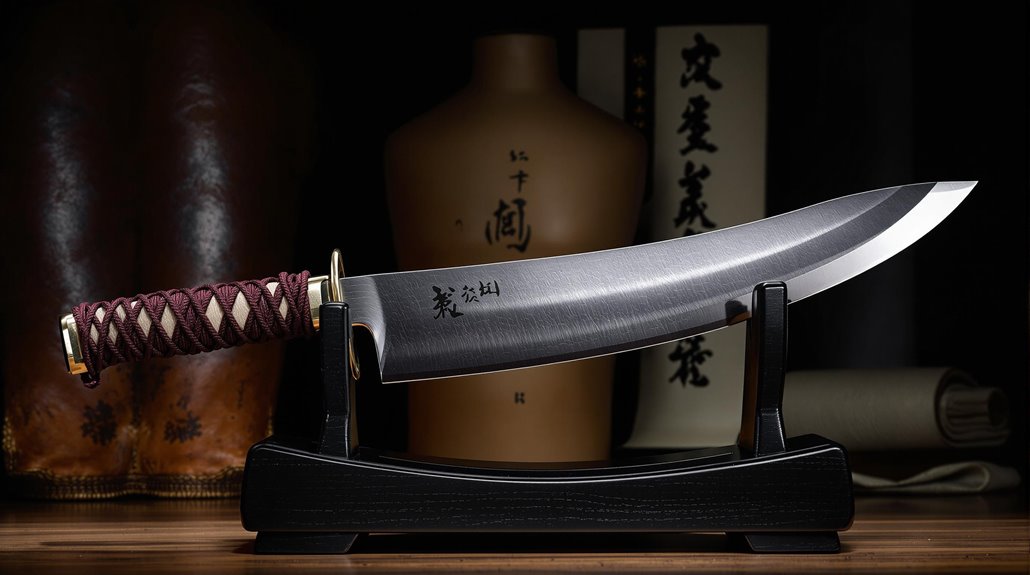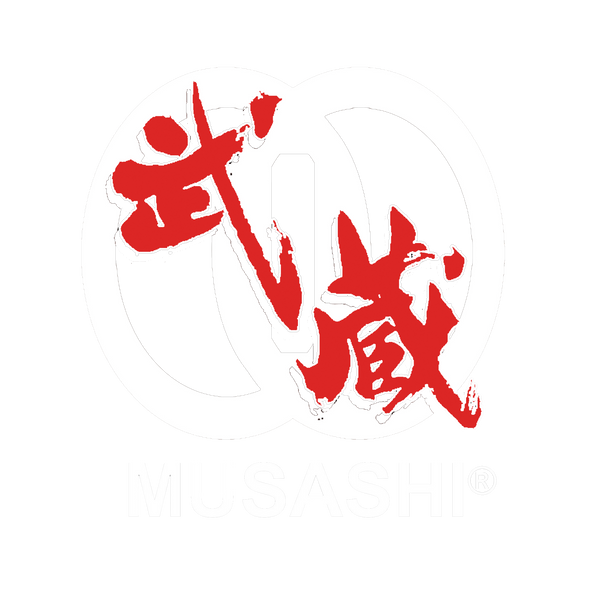
The Role of Tanto in Japanese Martial Arts
Share
The tantō showed up in Japan’s Heian time as a key short blade for fighting up close. Made from strong steel and measuring between 15-30 centimeters, it was used by samurai for both fighting and ceremonies. The blade worked well in tight spaces and as a backup weapon, which led to special fighting moves and ways of training. Today’s martial arts schools still use the tantō to teach old-style self-defense, how to take weapons away from attackers, and smart fighting skills.
Key Takeaways
- Tantō serves as both a traditional backup weapon and specialized training tool in multiple Japanese martial art disciplines.
- Students learn defensive techniques against knife attacks using wooden or rubber tantō in controlled practice environments.
- Classical kata forms preserve historical tantō combat methods while teaching fundamental principles of movement and blade control.
- The weapon’s compact size makes it ideal for close-quarter combat training and self-defense applications.
- Modern martial arts schools incorporate tantō training to develop precision, timing, and weapon awareness skills.
Historical Origins and Development of the Tantō
The tantō first appeared in Japan during the Heian period (794-1185) as a small, sharp knife with one cutting edge.
While it began in Japan, similar straight knives from other parts of Asia came before it. Both fighters and rich leaders started using the tantō not just as a weapon, but also to show their importance.
As time went on, knife makers in the Kamakura period (1185-1333) got better at making tantō blades. They created different styles, including flat-sided ones called hira-zukuri and special armor-piercing types called yoroi-dōshi.
The tantō reached its best years during the Muromachi period (1336-1573), when skilled makers created fancy designs for samurai warriors and regional lords.
Physical Characteristics and Construction Methods
The tantō blade shows clear features that come from skilled forging and fighting needs. These knives range from 15 to 30 centimeters long, with either one or two sharp edges made from strong steel. The smiths used special heating methods to make the cutting edge hard while keeping the back of the blade springy.
The blades were made from tamahagane steel, which smiths folded and hammered many times to clean out any dirt or flaws.
The handles were built differently based on how the knife would be used, using materials like rough ray skin, wrapped silk cord, and metal decorations. The way these knives were made helped them feel good in the hand and stay well-balanced.
Combat Applications in Traditional Japanese Warfare
The tantō played a critical role in close-quarter combat during Japan’s feudal period, particularly in situations where longer weapons proved impractical.
Warriors developed specialized techniques for penetrating weak points in samurai armor, targeting gaps between plates and striking through mail sections with precise thrusting motions.
Defensive applications included deflecting incoming blade attacks and executing rapid counter-strikes, making the tantō an imperative secondary weapon for samurai and other martial practitioners.
Close-Quarter Battle Techniques
Japanese fighters used small daggers called tantō when fighting in tight spaces where long swords didn’t work well.
These daggers were very useful inside buildings and during castle attacks. The small size of the tantō made it easy to pull out quickly and use along with hand-to-hand fighting moves.
Fighters would hold the dagger with the blade pointing down to block attacks while moving through narrow halls.
They mixed knife fighting with wrestling moves to switch between using weapons and just their hands.
They could also hide these daggers and keep them as backup weapons when they had to give up their swords.
Samurai Armor Penetration Methods
Samurai fighters used their long swords most often in battle, but they also learned special ways to use their short daggers to get through enemy armor. These daggers worked best when stabbed at exact spots where armor pieces met or where joints were less protected.
|
Weak Spot |
How to Strike |
Best Direction |
|
Under Arm |
Push upward |
Slanted 45° |
|
At Neck |
Strike down |
Straight down |
|
Between Plates |
Push straight |
Flat 30° |
Fighters spent many hours learning these moves until they could do them quickly, since they only had small chances to strike during fights. The dagger’s short size helped when fighting very close to an enemy, where longer weapons were hard to use.
Defensive Combat Strategies
Japanese warriors learned to use the tantō knife not just for attacking, but also for protecting themselves. The small blade helped fighters stay safe while guarding their vital body parts. Through practice, they got better at watching their surroundings and could block attacks coming from different directions.
- Holding the knife with blade pointing down helped block attacks from above and strike back quickly.
- Using the short blade made it easier to control and block attacks up close.
- Fighting with their back to walls or objects helped warriors keep enemies at the right distance.
The tantō became an important defensive tool in Japanese fighting styles, especially in tight spaces where long weapons didn’t work well.
Training Methodologies and Kata Forms
Traditional tantō training follows established sequences that progress from basic gripping and drawing techniques to advanced defensive maneuvers and counter-attacks.
Modern training methods incorporate wooden or rubber practice weapons alongside protective equipment to guarantee student safety while maintaining historical accuracy.
The kata forms practiced today originate from various classical Japanese martial traditions, with each system featuring unique sequences that emphasize different tactical applications of the tantō.
Traditional Training Sequences
Students learning knife combat in old Japan started with step-by-step practice moves that built the base for their fighting skills.
These basic moves taught them how to stand, move their feet, and handle the blade safely before they learned harder fighting methods.
- First lessons covered how to pull out the knife and hold it properly
- Middle-level practice included how to block attacks and strike back
- Higher-level training taught fighting multiple enemies and special battle situations
This way of learning helped students make the moves feel natural while following the important rules taught by their fighting schools.
Modern Safety Practices
Training with modern tantō knives follows careful safety rules and uses special practice equipment to keep students safe while learning real skills. Students start with wooden or rubber knives before moving up to metal ones.
Everyone must wear safety gear, including special clothes and masks when working with partners.
Students learn by doing slow, careful movements that stop at set points during practice. Before learning harder moves, students must show they can do basic steps safely and understand the safety rules.
Schools check and fix practice equipment regularly to make sure everything works safely.
Modern Schools and Training Systems Using Tantō
The tantō, though once a deadly weapon, is still used today in many Japanese martial arts schools as a training tool. Modern training centers teach students how to use the tantō through step-by-step lessons that mix old fighting methods with new self-defense skills.
Students can take part in tantō events where they show how well they can block attacks and take weapons away from opponents.
- Aikido schools use wooden tantō knives to teach students how to defend against and control knife attacks
- Ninjutsu schools teach both old and new ways of using the tantō
- Japanese police learn special moves to take tantō weapons away from dangerous people
The Tantō’s Influence on Contemporary Martial Arts Principles
The small dagger known as tantō has left a lasting mark on today’s martial arts, helping shape key training ideas that go beyond its fighting roots.
Many martial arts now teach tantō skills as a basic part of training, focusing on exact movements, self-control, and careful attention to form. These lessons help students improve their skills even when not using weapons.
Training with the tantō has helped martial artists better understand fighting distance, timing, and how to move in space.
Modern training halls use these ideas to teach students, helping them grasp body movement and real self-defense while keeping true to Japanese martial arts values.
Frequently Asked Questions
How Much Does an Authentic Historical Tantō Cost Today?
Genuine old tantō swords sell for different prices, from $5,000 to more than $50,000. The price depends on how old the sword is, how well it was made, its place in history, and who owned it before. The best tantō swords, made by famous craftsmen and good enough for museums, cost even more.
Can Foreigners Legally Collect and Own Tantō in Japan?
Foreigners can own Japanese tantō knives in Japan, but they must follow strict rules. They need special permits and paperwork, and must register their tantō with the police. Japanese weapon laws control who can own these knives and how they must be stored.
What Is the Survival Rate of Tantō Wounds Compared to Katana Injuries?
Records from the past show that people were more likely to live through wounds from tantō (short daggers), since these cuts were smaller and less deep compared to katana sword wounds. Still, whether someone lived or died mostly came down to where they were cut and how their body handled the injury right after.
Are There Any Female-Specific Tantō Designs From Feudal Japan?
Records show that while not many tantō knives were made just for women, some makers did create smaller, fancy ones for upper-class Japanese women to protect themselves and use in court ceremonies during feudal times.
Which Modern Military Units Still Incorporate Tantō in Their Combat Training?
Today’s Japanese military forces and some U.S. special forces learn about the tantō knife as part of their training. While they study its fighting methods and rich history, they mostly do this to understand Japanese military culture rather than to use it in real fighting.
Conclusion
The tantō’s enduring legacy in Japanese martial arts reflects its evolution from a practical battlefield weapon to a sophisticated training tool. Through centuries of refinement, its integration into various combat systems has preserved fundamental principles of close-quarter fighting while advancing technical precision and spiritual development. Modern practitioners continue to study tantō techniques, maintaining its relevance in traditional martial arts curriculum and contemporary self-defense applications. Experience authentic Japanese craftsmanship with Musashi Swords - your trusted source for traditional Japanese blades.
